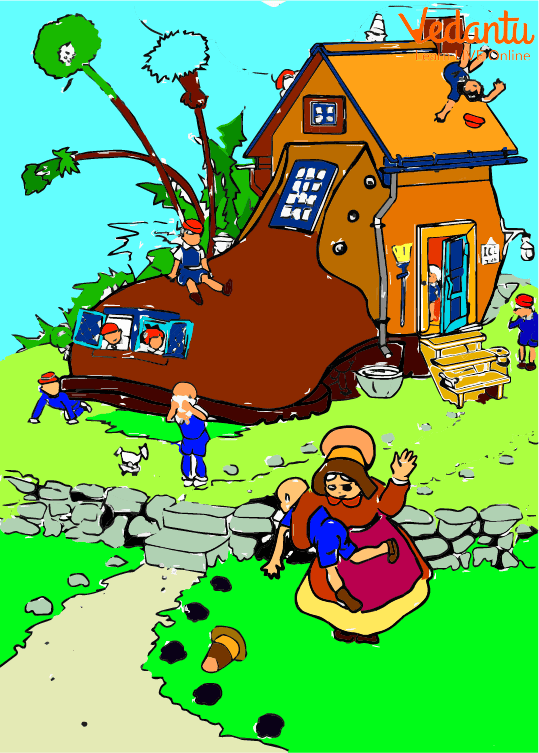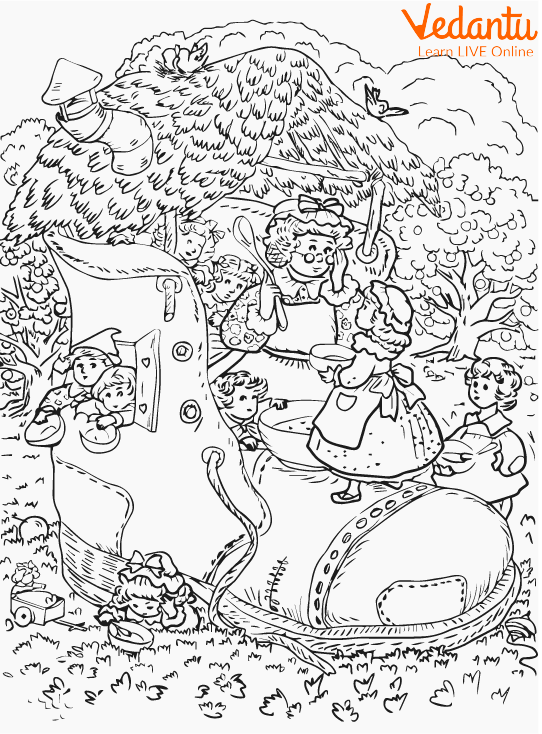Introduction to the Rhymes
“There was an Old Woman Who Lived in a Shoe” is one of the most seasoned and well-known kids' rhymes. It was first kept in 1794 in the Gammer Gurton's Garland variety by Joseph Ritson. Many scientists still guarantee that the verses could be more established than in this period.
You might have heard many stories and rhymes related to old women. But this one is different and you will get this when you read it once. This rhyme’s lyrics depict the story of that old woman and can you guess the house of that old lady? Yes, Shoe is the house of that lady. How would she manage there? Let’s find out in the article.

Old Woman Who Lived in a Shoe
"There was an Old Woman Who Lived in a Shoe" Lyrics
There was an old woman who lived in a shoe.
She had so many children, she didn’t know what to do;
She gave them some broth without any bread;
Then whipped them all soundly and put them to bed.
Frequency of "There was an Old Woman who Lived in a Shoe”
This popular nursery was written by Mother Goose, a famous creator of French fantasies and numerous other nursery rhymes. It was first distributed in Gammer Gurton's Garland in 1794. This rhyme explains the absence of a family in regrettable conditions. In the two variants, readers notice that anyhow of having unfortunate conditions, the mama is giving food to her youths.
Examination of Lyrical Bias
Academic and unpleasant items are both high-quality commercial items, but only a few are used in poem. When will a few of the great elements used in these rhymes be analysed?
Refrain a verse is an awful type of certain line. There's just a single chorus in this sonnet that contains four lines.
Quatrain: A quatrain is a four-lined chorus acquired from Persian verse. This sonnet has one quatrain.
Rhyme Scheme: The sonnet follows the AABB agreed plot.
End Rhyme: End minstrelsy is employed to make the chorus reverberative. For example," shoe/ do" and" chuck/bed."
Examination of the Literary Bias
Cultural widgets are the instruments employed by essayists to pass on their dispatches. They likewise act as effects to get simplicity from the textbooks. Mother Goose has skillfully employed scholarly widgets to make this agreement a show- breach. The examination of a portion of the scholarly widgets employed in this sonnet has been given underneath.
Sound similarity: Assonance is the repetition of vowel sounds in an analogous line; for illustration, the sound of/ o/ in “There was a senior person who lived in a shoe”.
Consonance: Consonance is the repetition of consonant sounds in an analogous line; for illustration, the sound of/ d/ in “And whipped them all sufficiently and put them to sleep”.
Symbolism: Imagery is employed to create perusers to see effects, including their five detects. For example, “There was a senior person who lived in a shoe” and “She gave them some stock with no chuck”.
Illustration: It's a concept wherein a suggested examination is made between the papers different in nature. Living in a shoe is an illustration of pauperism or a hopeless life.

Woman in a Shoe
Imagery Symbolism is an application of images to connote studies and characteristics, by giving them representational counter-accusations that aren't quite the same as their strict counter-accusations. The shoe represents a cabin or a little house.
Summary
In this article, the famous rhyme of the old lady in the shoe with lyrics is shared. Lyrics described the story of that old lady. There became an old lady who lived in a shoe. She had so many kids that she didn't understand what to do. She gave them a few broths without any bread. She whipped them all soundly and positioned them on the mattress. These could likewise be employed to show a mama's anxiety for her youths. Thus, in this their lifestyle is described here.


FAQs on Little Old Lady Who Lived in a Shoe
1. What's representative of the misery of the “There was an Old Woman Who Lived in a Shoe” lyric?
The short minstrelsy portrays the actuality of a senior person who lives in a shoe with her kiddies. She battles to deal with them. This short sonnet talks a great deal about the scores of that old mama. It likewise features her abidance in worrisome conditions. In the main adaptation of the minstrelsy, the mama is disappointed. Be that as it may, in the posterior one, the mama is patient and positive anyhow of their impecuniousness.
2. What are the major themes in the lyric “There was an Old Woman Who Lived in a Shoe”?
Abidance and mama's adoration are the significant motifs of this sonnet. By all accounts, the sonnet shows the battle of a lady who figures out how to get by in a little house with her kiddies. She gives them food and cares for them well. In a more profound position, this introductory poetry captures the hopeless dilemma of that woman who's making an honest effort to master the tough spot of her life. She's upset for her kiddies' substance and gives her all anyhow of whether it causes her to come bothered.
3. What fairytale lives in shoes?
The Little Old Woman Who Lived in a Shoe is one of our Favourite Fairy Tales, published in My First Picture Book, Printed in colours by Kronheim (1875). You might also enjoy reading Mother Goose's nursery rhyme, There was an Old Woman Who Lived in a Shoe.
4. How did Lord George use this poem?
Lord George II and his significant other, Queen Caroline, both have been professed to be the personality of this poem, for they had eight kids together, being individuals from a congress that the sovereign himself did not control effectively. The verses were much of the time put with respect to his primary aim to re-establish his family and country. Lord George was numerous times nicknamed an old woman during his rule.





